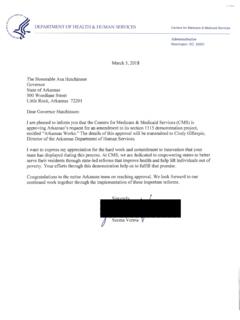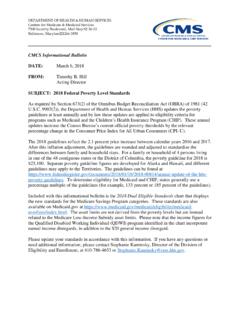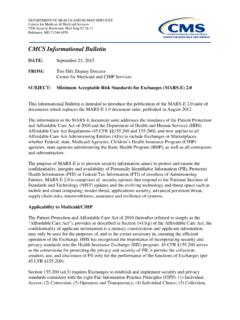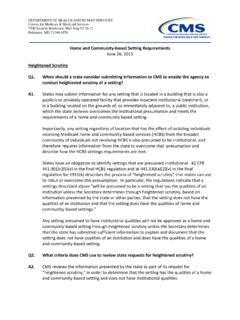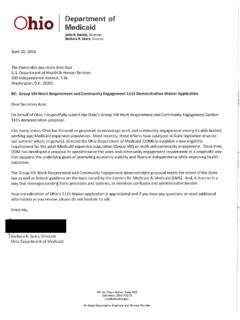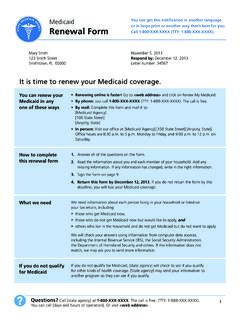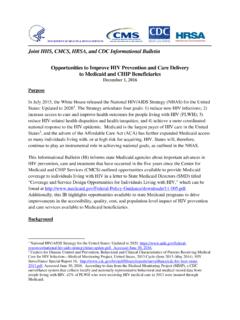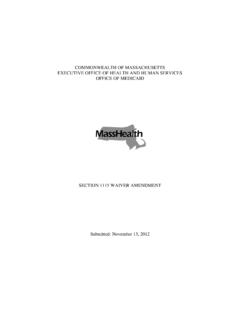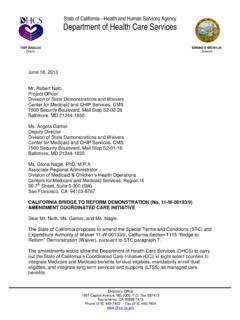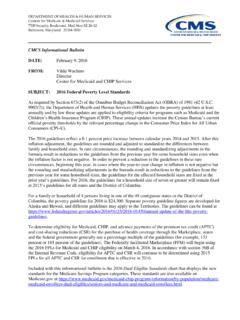Transcription of Community Engagement SMDL - Medicaid.gov
1 DEPART MENT OF HEALT H AND HUMAN SERVICES. centers for medicare & medicaid Services 7500 Security Boulevard, Mail Stop S2-26-12. Baltimore, MD 21244-1850. SMD: 18-002. RE: Opportunities to Promote Work and Community Engagement Among medicaid Beneficiaries January 11, 2018. Dear State medicaid Director: The centers for medicare & medicaid Services (CMS) is announcing a new policy designed to assist states in their efforts to improve medicaid enrollee health and well-being through incentivizing work and Community Engagement among non-elderly, non-pregnant adult medicaid beneficiaries who are eligible for medicaid on a basis other than disability. 1 Subject to the full federal review process, CMS will support state efforts to test incentives that make participation in work or other Community Engagement a requirement for continued medicaid eligibility or coverage for certain adult medicaid beneficiaries in demonstration projects authorized under section 1115 of the Social Security Act (the Act).
2 Such programs should be designed to promote better mental, physical, and emotional health in furtherance of medicaid program objectives. Such programs may also, separately, be designed to help individuals and families rise out of poverty and attain independence, also in furtherance of medicaid program objectives. 2. This guidance describes considerations for states that may be interested in pursuing demonstration projects under section 1115(a) of the Act that have the goal of creating incentives for medicaid beneficiaries to participate in work and Community Engagement activities. It addresses the application of CMS' monitoring and evaluation protocols for this type of demonstration and identifies other programmatic and policy considerations for states, to help them design programs that meet the objectives of the medicaid program, consistent with federal statutory requirements.
3 1 States will have the flexibility to identify activities, other than employment, which promote health and wellness, and which will meet the states' requirements for continued medicaid eligibility. These activities include, but are not limited to, Community service, caregiving, education, job training, and substance use disorder treatment. 2. Section 1901 of the Social Security Act authorizes appropriations to support State medicaid programs: For the purpose of enabling each State, as far as practicable under the conditions in such State, to furnish (1) medical assistance on behalf of families with dependent children and of aged, blind, or disabled individuals, whose income and resources are insufficient to meet the costs of necessary medical services, and (2) rehabilitation and other services to help such families and individuals attain or retain capability for independence or self-care[.]
4 ] . Page 2- State medicaid Director Health Benefits of Community Engagement , including Work and Work Promotion While high-quality health care is important for an individual's health and well-being, there are many other determinants of health. It is widely recognized that education, for example, can lead to improved health by increasing health knowledge and healthy behaviors. 3 CMS recognizes that a broad range of social, economic, and behavioral factors can have a major impact on an individual's health and wellness, and a growing body of evidence suggests that targeting certain health determinants, including productive work and Community Engagement , may improve health outcomes. For example, higher earnings are positively correlated with longer lifespan.
5 4. One comprehensive review of existing studies found strong evidence that unemployment is generally harmful to health, including higher mortality; poorer general health; poorer mental health; and higher medical consultation and hospital admission rates. 5 Another academic analysis found strong evidence for a protective effect of employment on depression and general mental health. 6 A 2013 Gallup poll found that unemployed Americans are more than twice as likely as those with full-time jobs to say they currently have or are being treated for depression. 7. Other Community Engagement activities such as volunteering are also associated with improved health outcomes 8, 9, and it can lead to paid employment. CMS, in accordance with principles supported by the medicaid statute, has long assisted state efforts to promote work and Community Engagement and provide incentives to disabled beneficiaries to increase their sense of purpose, build a healthy lifestyle, and further the positive physical and mental health benefits associated with work.
6 CMS supports state efforts to enable eligible individuals to gain and maintain employment. Optional medicaid programs such as the medicaid Buy-In, for example, allow workers with disabilities to have higher earnings and maintain their medicaid coverage. For beneficiaries who are able to work but have been unable to find employment, some states encourage employment through concurrent enrollment in state- sponsored job training and work referral, either automatically or at the option of the medicaid beneficiary. A number of states have also initiated programs to connect non-disabled medicaid beneficiaries to existing state workforce programs. States also provide a range of employment supports to individuals receiving home and Community based services under section 1915(c) waivers or section 1915(i) state plan services.
7 These include habilitation services designed to assist individuals in acquiring, retaining and improving the self-help, socialization, and adaptive skills necessary to reside successfully in 3. Bartley, M and Plewis, I. (2002) Accumulated labor market disadvantage and limiting long term illness. International Journal of Epidemiology 31:336-41. 4. Chetty R, Stepner M, Abraham S, et al. The association between income and life expectancy in the United States, 2001-2014. JAMA. 2016; 315(16):1750-1766. 5. Waddell, G. and Burton, AK. Is Work Good For Your Health And Well-Being? (2006) EurErg Centre for Health and Social Care Research, University of Huddersfield, UK. 6. Van der Noordt, M, Jzelenberg, H, Droomers, M, and Proper,K.
8 Health effects of employment: a systemic review of prospective studies. BMJournals. Occupational and Environmental Medicine. 2014: 71 (10). 7. Crabtree, S. In , Depression Rates Higher for Long-Term Unemployed. (2014). Gallup. 8. United Health Group. Doing good is good for you. 2013 Health and Volunteering Study. 9. Jenkins, C. Dickens, A. Jones, K. Thompson-Coon, J. Taylor, R. and Rogers, M. Is volunteering a public health intervention? A systematic review and meta-analysis of the health and survival of volunteers BMC Public Health 2013. 13 (773). Page 3- State medicaid Director home and Community based settings."10 These activities have been historically focused on services and programs for individuals with disabilities and receipt of these supports is not a condition of eligibility or coverage.
9 The successes of all these programs suggest that a spectrum of additional work incentives, including those discussed in this letter, could yield similar outcomes while promoting these same objectives. New Opportunity for Promoting Work and Other Community Engagement for Non- Elderly, Non-Pregnant Adult Beneficiaries Who Are Eligible for medicaid on a Basis Other than Disability On March 14, 2017, the Department of Health and Human Services (HHS) and CMS issued a letter to the nation's governors affirming the continued commitment to partner with states in the administration of the medicaid program. In the letter, we noted that CMS will empower states to develop innovative proposals to improve their medicaid programs. Demonstration projects under section 1115 of the Act give states more freedom to test and evaluate approaches to improving quality, accessibility, and health outcomes in the most cost-effective manner.
10 CMS is committed to allowing states to test their approaches, provided that the Secretary determines that the demonstrations are likely to assist in promoting the objectives of the medicaid program. Some states are interested in pursuing demonstration projects to test the hypothesis that requiring work or Community Engagement as a condition of eligibility, as a condition of coverage, as a condition of receiving additional or enhanced benefits, or as a condition of paying reduced premiums or cost sharing, will result in more beneficiaries being employed or engaging in other productive Community Engagement , thus producing improved health and well-being. To determine whether this approach works as expected, states will need to link these Community Engagement requirements to those outcomes and ultimately assess the effectiveness of the demonstration in furthering the health and wellness objectives of the medicaid program.
